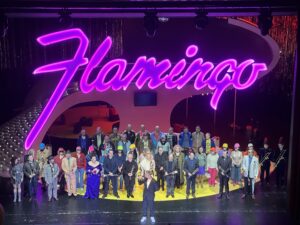Over the weekend, I was able to see not one but two different operas, Handel’s Agrippina and Tchaikovsky’s Pique Dame. As someone who had never seen an opera before, it was a very interesting and fun experience! One thing that I was especially surprised and intrigued by was how much freedom directors seem to have when choosing the staging and setting of their production. In both productions, many of the decisions made for the staging were beyond what the original writers could ever have imagined, including using props or ideas which did not even exist when they were alive.
I want to now focus on one of the operas, Agrippina, and how I felt the staging worked well in conveying the setting and atmosphere of the different scenes. Agrippina follows the ancient Roman story of Agrippina’s schemes to install her son, Nero, as the emperor. This production, however, was set in a Las Vegas casino called Caesar’s Palace. Something that jumped out to me immediately was the fact that the set did not change throughout the opera, nothing about the scene was added or removed, and the only motion of the stage itself was its ability to rotate. However, the setting did not feel too static because the set had several different areas which were connected, but could be made to feel separate when necessary. These were a main lobby area with a long couch, a gambling/bar area with several tables, and an upstairs section with a large staircase leading up to it. These separate areas, I felt, were used quite effectively to convey the moods of the different scenes. The upstairs area, for example, was at times used as an overlook for large and busy scenes where a character needed to address a crowd of people below in the main area. However, by turning the set, the wide stairs blocked the audience’s view of other areas and allowed the stairs and upstairs area to be used as a more intimate setting for Agrippina’s secret dealings. A similar effect could be achieved with the other areas as the set was wide but not long, so rotating it could make certain areas feel smaller or larger depending on what was necessary for a certain scene. This was also combined with good use of lighting, such as changing the color of the large billboard sign to make the main area feel darker or otherwise different for scenes with a more isolated mood which made use of the couch. Overall I felt this was quite an interesting introduction to the world of opera, and it definitely opened my eyes to how much freedom and creativity is possible now, even through such an old art form.

So glad you enjoyed this! I thought it worked really well — but I would recommend — if you have chance — that you take a glance at the Met Production online through Princeton
https://catalog.princeton.edu/catalog/99127165556606421
It takes the party feeling, but I think is more inventive in the staging. I will do a post about that at some point! Agrippina is a wonderful piece — and baroque opera has a very different feel than the Tchaikovsky! But I’m so glad you were able to experience it!